by Leonard Feldman
NEARLY FIFTEEN YEARS ago, the fledgling Institute of High Fidelity undertook what seemed like an impossible task-the formulation of measurement standards for FM and AM tuners. Until that time, most manufacturers published performance specifications based upon standards that had been issued by the Institute of Radio Engineers (now the IEEE) in 1947, just after the birth of commercial FM broadcasting on a national scale. High fidelity component manufacturers realized that the tuner of 1958 could no longer be judged by measurements devised in 1947. To the everlasting credit of a few brave engineers affiliated with what was then a very tiny segment of the home entertainment electronic industry, the "new" standards were issued in late 1958. Before long, everyone who hoped to sell high quality FM receiving equipment adopted the newer standards and a relative measure of specification standardization prevailed.
If you can remember 1958 clearly, you'll recall that in that year, FM stereo was just a dream in the mind of Murray Crosby. Transistors had been invented a decade or so earlier, but were to be found only in a few, expensive imported AM "pocket" radios which presupposed your having pretty large pockets. In short, the "new" tuner specs of 1958 are pretty well outdated and it's time for their retirement-or rejuvenation, if you just can't bear to see "old specs die". As of this writing, the IHF has again turned to the matter of measurement standards and, hopefully, it won't be long before updated standards will be proposed and, accepted by the industry at large. As one who has had to deal with the "old" specs both in my daily work and in the course of reviewing the performance of various FM products for readers of AUDIO, I'd like to propose a few ideas for consideration by the newly formed committee and, perhaps, come up with a set of more meaningful specifications in the light of today's state-of-the-art FM product.
Down With IHF Sensitivity!
If you read FM tuner spec sheets as I do, you may have wondered whether or not there is really a meaningful, audible difference between a tuner that boasts, say 1.9 µV IHF sensitivity and one that shamefacedly admits to only 2.0 µV. The fact is the neither product sounds particularly good when fed with its "least usable sensitivity" signal (a once-popular synonym for "IHF sensitivity"). That is because with such a minimal signal applied to the antenna terminals, the total noise and distortion content of the resultant audio output will be some 3%. If this percentage consists primarily of distortion (THD), you'd hardly want to listen to the program. If the content is primarily noise-why, even a cheap cassette machine (the garden variety "dictating machine" type) can provide a better signal-to-noise ratio than that.
Your low-level phono-preamplifier nearly always boasts at least 60 dB of S/N and high-level inputs of amplifiers are capable of 75 or even more dB of dynamic range above noise level. Why worry, then, about whether it takes 1.8 or 1.9 µV of signal input to produce a "listenable" signal that you wouldn't want to listen to?
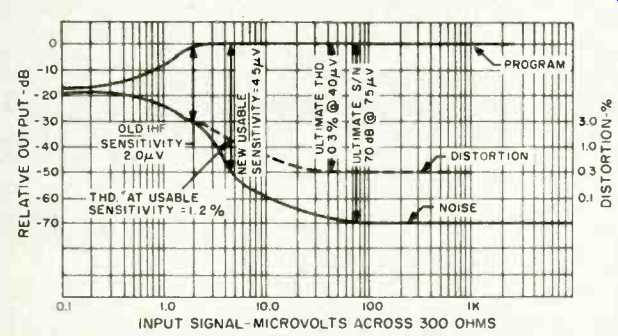
Fig. 1--New, more meaningful FM mono performance specifications include
usable sensitivity, THD at usable sensitivity, ultimate THD and ultimate
S/N.
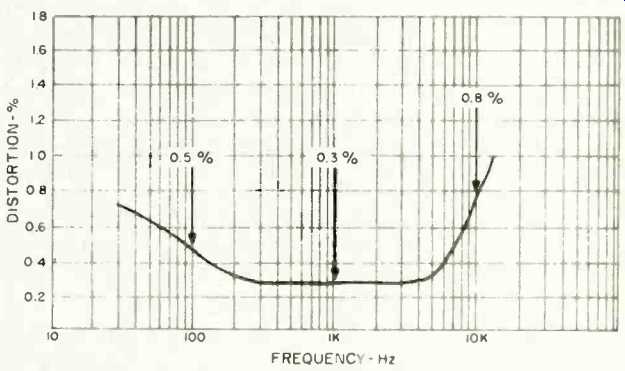
Fig. 2--FM Mono THD versus frequency. Standards would require statement
of THD at 3 key frequencies.
Usable Sensitivity
Suppose that instead of "least usable sensitivity" we propose that manufacturers specify the least signal which will provide a 50 dB signal-to-noise ratio. Such an S/N is quite listenable, with just a bare trace of background noise. A comparison between this proposed spec and the IHF sensitivity for a given receiver is shown in Fig. 1. The new specification could be stated as: Usable Sensitivity (50 dB S/N); 4.5 µV. Since THD and noise (both unwanted signal content) were correctly linked together by the creators of the original IHF specs, an accompanying specification should be: THD at Usable Sensitivity. The number will always be less than 3% and, in our example of Fig. 1, turns out to be a very listenable 1.2%. We're all for continuing the practice of quoting "ultimate" S/N, but feel that instead of arbitrarily measuring it at 1000 µV signal input, some statement should be made establishing just what the signal input has to be before this "ultimate" or best S/N is reached. That kind of statement would really separate the "men from the boys". Thus, a typical specification might read: Ultimate Signal-to-Noise: 70 dB at 75 µV input and you'd know that the set has a better, faster quieting characteristic than one which states: Ultimate S/N: 70 dB at 150 µ.V. This idea is conveyed in Fig. 1 as well and the same approach could be used to define lowest harmonic distortion (THD), which, in our example would be stated as: 0.3% with 40 µV input.
THD vs. Frequency
Although the old IHF specs rightly recognized the fact that the de-emphasis curve built into the tuner output circuitry tends to make THD readings above 1 kHz or so look "better" than they would otherwise be, we find an increasing tendency on the part of many quality manufacturers to quote THD for frequencies above and below the nominal 1000 Hz and believe that this is a trend in the right direction. Thus, in our new specs, we'd propose that THD be quoted for 100 Hz, 1 kHz and 10 kHz as a minimum, with a full plot (as shown in Fig. 2) optional-but desirable. You're probably not too surprised to find that in our example, THD tends to be higher at the extremes of the audio spectrum de-emphasis notwithstanding. It wouldn't be a bad idea if manufacturers were asked to specify nominal THD at some high signal level-such as a volt or more, since it is well known that some input circuits can be overloaded with disastrous effects as far as distortion is concerned.
All of the other specs relating to mono performance are quite acceptable, as far as we're concerned, and they are tabulated at the end of this discussion for you to examine.
Before going on to stereo-related specs (of which there are none in the existing pre-stereo standards), one brief word about AM suppression. The true severity of the problem of "multipath signal reflections" in terms of their effect on FM and stereo FM listening has only recently been studied in detail by the FM technical fraternity. Admittedly, AM suppression has been a recognized "spec" all along, but again, it is only measured with reference to a signal level of 1000 µV--and that's not always available for every FM listener. A better approach would be to quote AM suppression referenced to the new "Usable Signal" level as well as to the usual 1000 µV reference. Still better would be a continuous plot of this characteristic, as shown in Fig. 3. Multipath interference often creates AM signal components and the ability of a tuner to reject such components is directly related to how multipath reflections are likely to affect your FM (and especially your FM stereo reception. The new spec would read: AM Suppression: 50 dB at Usable Input; 65 dB at 1000 µV input.
Specs For FM Stereo
Most high fidelity component manufacturers, having no guidance from some central authority, have created a set of stereo FM specs to define performance of this portion of their circuitry. Usually included are: "Stereo Separation at I kHz" and, more often than not these days, "THD, Stereo at I kHz". While we don't think that extremely high orders of separation are that important for a satisfactory stereo localization effect, a more complete specification should, minimally, include separation capability at 100 Hz and 10 kHz. In equipment reviews published in AUDIO, we always show a plot of separation versus frequency, as illustrated in Fig. 4.

Fig. 3-Relative Importance of AM suppression In FM equipment should be
stressed in new standards.
Fig. 4-Separation for FM stereo should be stated in new specifications for at least three frequencies.
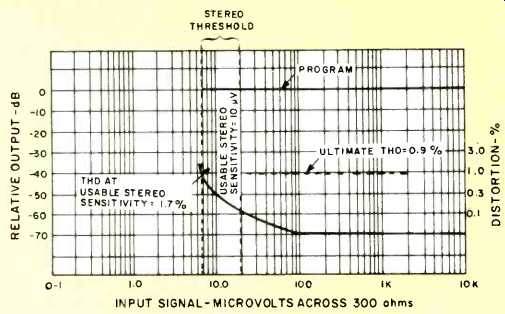
Fig. 5--FM stereo performance characteristics should be plotted or stated
separately in new standards.
Stereo Usable Sensitivity
It is by this time well known that signal-to-noise ratios for stereo FM listening are inferior to those typical in monophonic performance. The reasons have to do with the nature of the composite signal and its wider bandwidth, but anyone who has switched a noisy stereo FM program back to mono knows that mono produces inherently quieter background noise. Some manufacturers "let the noise fall where it may" when the mode switch is set to "Stereo FM". Others only permit the set to "switch to stereo" when a reasonably strong input signal is provided at the antenna terminals. In either case, a specification calling out "Usable Stereo FM Sensitivity" is needed, and its parameters could be exactly those applied to the Usable Sensitivity described earlier-the signal required to produce 50 dB of S/N in the presence of a stereo FM broadcast. A THD specification referenced to this Usable Stereo Sensitivity should accompany this primary spec as well. Thus, the two specifications might read: Usable Stereo Sensitivity (50 dB S/N): 10 µV. THD at Usable Stereo Sensitivity: 1.7%. For the manufacturer who really wants to go all out, a graph completely analogous to Fig. 1, such as that shown in Fig. 5, could be presented. This graph would also define "Stereo Threshold" level for such tuners or receivers that switch from mono to stereo at a pre-determined signal level. Since there are some sets which provide a variable adjustment for this switching, the range of adjustment could be easily shown in the same graph. Often, residual 19 kHz, 38 kHz and harmonically related products appear in the outputs of a stereo tuner or receiver. Their level should be quoted separately (and is already, by a goodly number of manufacturers), but if it is less than 50 dB down from program level at 100% modulation, the manufacturer should be permitted to insert a low-pass (15 kHz cut-off) filter when making his Usable Stereo Sensitivity and THD measurements, since these components, while objectionable, are not truly "noise" or "distortion" in the traditional sense and do not contribute directly to our audible displeasure.
Ordinary THD at various frequencies, with the set operating in the stereo mode, poses certain problems which are not present when THD is measured in the mono mode.
Because of the presence of super-audible frequencies in the multiplex decoder section of an FM tuner or receiver (19 kHz, 38 kHz, etc.), any non-linearities in the circuits will result in the generation of "beat" frequencies between the desired audio program tone and one or more of these subcarrier high frequencies. For example, a desired 12 kHz tone beating with the locally generated 19 kHz pilot carrier signal may result in a 7 kHz difference signal. A variety of other mathematical combinations are possible and do, in fact, occur in varying degrees when static THD measurements are attempted. The ordinary distortion analyzer cannot discriminate between these extraneous signals and true harmonic distortion and, as a result, some very high "THD readings" may be obtained when specific frequencies are used to modulate the FM test generator in stereo THD measurements. Audibly, these "beats" never seem to sound quite as bad as they appear in static tests-probably because their duration is so short under true musical program conditions.
Nevertheless, we do feel that a graphic plot, or at least a statement of THD versus frequency for 100 Hz, 1 kHz and 5 kHz should be included in the new stereo test specifications. 5 kHz is chosen in this instance simply because the measurable "beats" discussed tend to occur when higher frequencies are applied and should not affect true THD readings if they are limited to the frequencies just selected.
A full graphic plot is shown in Fig. 6.
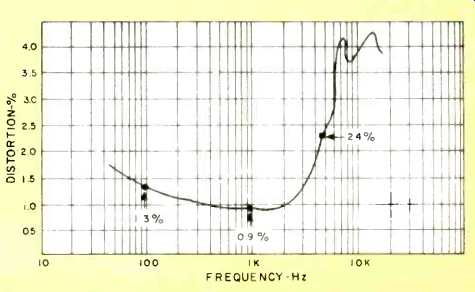
Fig. 6--THD in stereo versus frequency will show up undesirable "Beat'" signals.
A statement regarding the presence of residual subcarrier products at the output is sometimes given by manufacturers and, in our opinion, this specification should become mandatory, since the presence of significant amounts of 19 kHz, 38 kHz or harmonics can seriously affect tape recordings made "off the air". Bias oscillators used in tape recording products also operate at super-audible frequencies and may "beat" with, say, any residual 76 kHz present in the output of the tuner or receiver. While the individual high frequencies may not be audible in the recording, the "beats" themselves may well fall within the audible range and can destroy a well-planned and otherwise flawlessly executed recording.
Tuning Accuracy and Drift
Drift of an FM set after warm-up was included in the old IHF tuner standards and, for many years, most manufacturers included this specification in their brochures. More recently, however, solid state designs (and the attendant reduction in component heating) has reduced overall drift in most of the better tuners to very low values. As a result, most manufacturers have eliminated this specification entirely. In all fairness to those FM products which have lately appeared and which employ phase-lock-loop circuitry referenced to a highly accurate crystal controlled oscillator, we feel that a statement regarding drift should be required once more--if only to point up and justify the extra design cost inherent in the more sophisticated phase-lock-loop approach to tuning accuracy. In the case of these new tuners the drift figure might well be measured in Hz, rather than kHz, but that would provide an opportunity for the prospective purchaser to see just how stable the new products really are.
It is, of course, impossible to predict the course of future FM developments today any more than the writers of the 1958 Standards could have foreseen the need for the changes and additions recommended in this article. Undoubtedly, a means for multi-channel broadcasting (quadraphonic or, perhaps, even more channels) will eventually be sanctioned by the FCC. Considerations of this problem are only just beginning, and it is likely to be some time before we are presented with a new composite signal that may require still newer specifications and measuring techniques. Nevertheless, to wait until those deliberations are concluded would, in my opinion, be .a serious error, since technological advancement is a never ending thing and the standards we approve this year, or next, are likely to need revision at some time in the future regardless of how intelligently we write them now.
The modifications for the FM Standards just discussed are by no means all-inclusive. As the new committees are formed, other suggestions are likely to emerge and, for that matter, any readers who have ideas relative to new FM Measurement Standards are invited to send them along to the Institute of High Fidelity, at 516 5th Avenue, New York, N.Y. 10036, attention: Chairman, Standards Committee.
Note: Len Feldman is now Chairman of the above committee--a most appropriate choice. -Ed.
=========
If all of my suggestions were followed and incorporated in a new set of IHF Tuner Standards, a future "spec sheet" for the tuner of 1974 might well look like this:
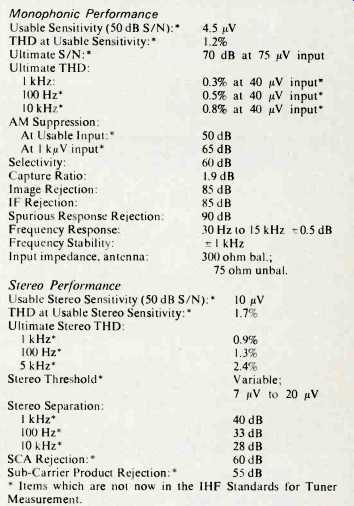
=============
(Audio magazine, Jan. 1973)
Also see:
How to evaluate FM stereo tuner performance (Jan. 1972)
AM Stereo: An FCC Fiasco (July 1982)
FM Fidelity: Is The Promise Lost? (March 1985)
The Problem with FM (March 1985)
= = = =